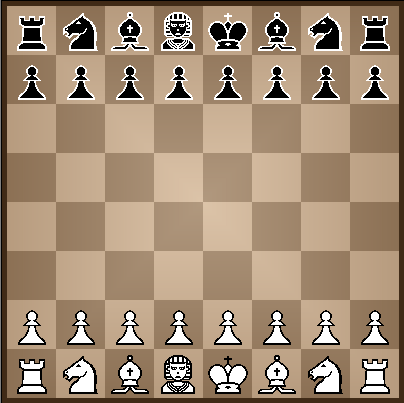Cleopatra Chess
By W. D. Troyka
Rules
Standard chess rules apply, except:
There is no capturing.
The Queen is replaced by a Cleopatra. The Cleopatra seduces any enemy piece (except the enemy Cleopatra) that she attacks at the end of her move. A seduced piece immediately changes sides.
Win by seducing the enemy King.
The Cleopatra

Commentia
Cleopatra Chess is a pure flipping chess variant in the mold of Benedict Chess, but (somewhat) less chaotic. The Cleopatras should be brought out as soon as possible, with Black tracking White's moves for the first two rounds. Offense consists principally of seducing lots of enemy pieces. Pieces of either color serve as blocks to the seductive power of the Cleopatra. Friendly pieces, however, can be moved away to expose the enemy King.Defense consists of keeping the King snugly surrounded in a "fortress" as it is at the start of the game. Adjacent enemy pieces can serve as part of the protective wall, although they are not reliable. One exception is that flipped Pawns on your second rank can present a barrier to the opponent. If the corresponding squares on the first rank are occupied, the Pawns are completely immobilized. It is possible to pin the enemy Cleopatra so that it cannot move without exposing the King, which gives you plenty of time to develop an attack.
The game is stricly positional and the full complement of pieces remains on the board at all times. Typically a Cleopatra wins by seducing a protector of the enemy King, moving the seduced piece away to expose the King, and attacking the King. The enemy King cannot actually be converted without motion by the Cleopatra.
Draws are unlikely. Although powerful fortresses can be built, they inevitably fall to a player with more material.
Computer Play
An implementation of Cleopatra Chess has been written for Zillions of Games.Written by W. D. Troyka.
WWW page created: January 20th, 2003.